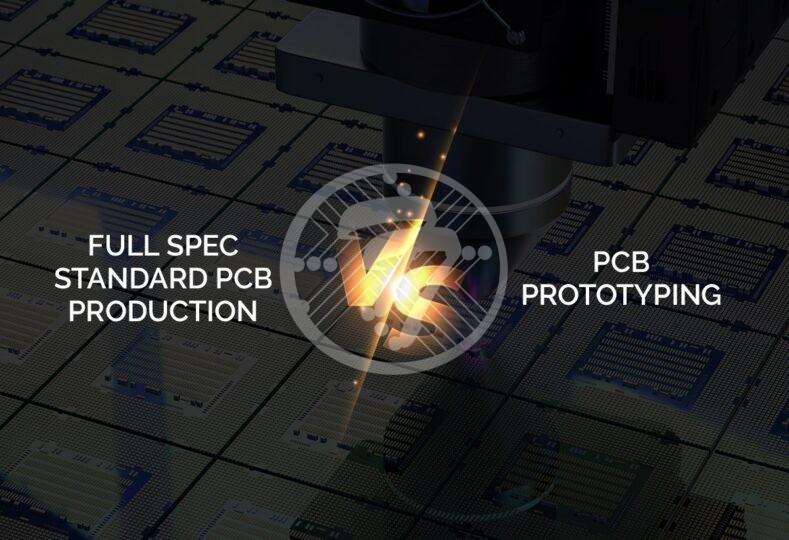What is the difference between full spec standard PCB production and PCB prototyping?

PCB Prototyping and full spec production are processes that are part of a continuum. Essentially, the process of PCB production begins by creating a design, which is then prepared on a board layout and then tested by way of prototypes. The initial tests help with ironing out any issues involved with prototype, so that the product can be put through final production. Let us look at both the processes and the difference between them, in some detail:
PCB Prototyping
The biggest advantage that PCB prototyping offers is that it allows you to test the concept before you commit to mass production. Not only does it help to maintain the reliability of the circuit board, it also helps you to remain competitive. In fact, PCB prototyping allows you to develop boards to the exact specifications and test them so as to avoid costly errors in the future. Any flaws discovered at the stage of the prototype, whether it is in terms of design or manufacturing defects, can be easily addressed. Simply put, the prototype ensures that the design is indeed worth putting into a full production run.
At this stage an experienced PCB manufacturer who specializes in PCB prototyping is the need of the hour. An experienced manufacturer is armed with industry best practices and can ensure that the design works as it is intended. The prototyping stage, thus, is clearly beneficial in working out any errors before investments in any large production runs, is made.
Also checkout : Fast PCB prototype in the USA
The benefits that PCB prototyping offers are as below:
- It makes it possible to test the design and correct any defects early.
- It improves time-to-market. Even though going through several iterations sounds like it can create lengthy timelines, the fact remains that as a whole PCB prototyping helps speed up the design and manufacturing process. This is made possible on account of the fact that it takes away the guesswork, and it also minimizes rework. In fact with prototypes, you can see and test the board before the full production run, thereby minimizing time spent on redesigns once a large production run has been made.
- It proves to be cost-effective as you tend to save on potential costly errors. In other words, a prototype allows you to fail fast and also fail inexpensively.
- It offers opportunities for iteration and innovation, thus improving functionality. With a prototype you tend to gather accurate requirements that go a long way in making the final design, robust.
- It lends itself to small batch production that helps in testing quality. In fact, a functional prototype can help to address any challenges in the design. These solutions can then be applied when you move to the stage of full production. At the prototype stage, you can do several different iterations and thereafter benchmark the resulting performance.
- With a functional prototype, what you also tend to gain is the probability of your idea being funded.
- A prototype also demonstrates “reduction to practice.” Also, through the prototyping process, you tend to develop a number of aspects such as patent drawings and the inventor’s logbook, which in turn, make it easier to file for patents.
Also checkout benefits of Prototype PCB manufacturing in details.
Full Spec Production
Once the efficacy of the prototype is established i.e the prototype meets the performance requirements, a full spec production schedule begins. With full spec production you are typically working on a large volume. With prototyping already done and issues ironed out, this stage tends to be far smoother. Also, once it has been successfully established that the basic prototype boards are working well, the PCB design can be further enhanced to improve functionality.
Some of the scenarios in particular, where a full spec production must necessarily be preceded with a prototype include:
- If the project involves a new design or function.
- If the project is particularly complex and has multiple components.
- Where extensive testing is required.
- Where you need a visual representation of a physical design.
Given the differences between the two, you sure need to choose the right PCB contract manufacturer who can offer you low volume prototypes with quick turnaround times and when you are ready to move to the full production stage, also have the capacity to cater to large production runs.
At TechnoTronix, we combine state-of-the-art technology with our advanced engineering to deliver unmatched quality and service. With PCB prototyping and consistent delivery of high-quality PCBs, we offer a robust source of competitive advantage to our clients. Visit to know more about PCB prototyping service and feel free to contact us at [email protected].






